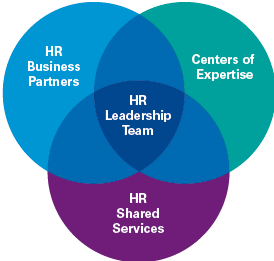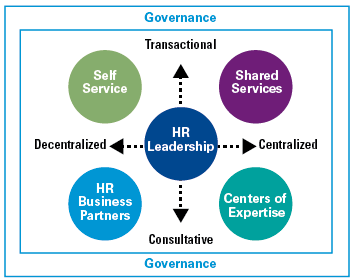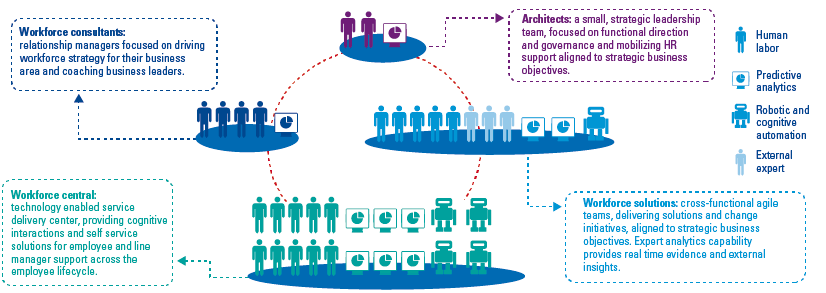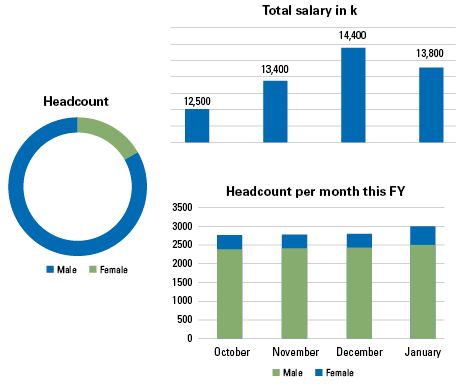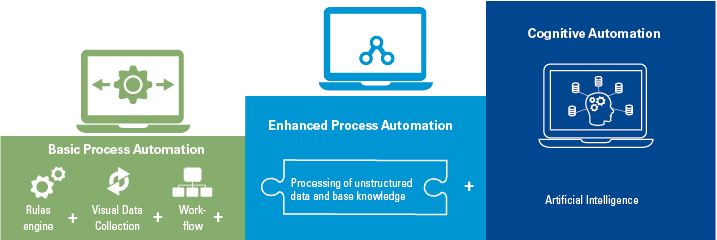The expectations of Millennials about their work environment, labor shortages, changed expectations of HR service delivery and of course the opportunities that robotics, enabling technology and data analytics offer, force organizations and HR in particular to adapt and prepare for the future. A future where people take center stage, because they add unique value to the organization.
Since people are one of the most important resources for the organization, they require a Chief HR Officer to be a strategic partner in the Board of Management and to support topics that are becoming more important for them, such as talent management, strategic workforce and succession planning. To meet the new expectations and offer suitable HR services, organizations can no longer hold on to the classic Ulrich model.
The future of HR demands an HR model that can quickly change along with economic and technological developments, on a large scale, and without restrictions. Roles as architects and multi-disciplinary teams enter the arena, to benefit from new technologies. Organizations cannot afford not to embrace change, if they want to avoid being overtaken by the competition.
Changed expectations and influences increase the value of people
What is the most important resource impacting organizations in our knowledge driven economy, but also in transport and logistics, healthcare and any other sector? People. It is not production or operations that allow the organization to function, these have probably already been automated or robotized, as in the automobile and chemical industry. The unique value that organizations are always looking for, are people. They are the ones who constantly translate customer needs into new product and service offerings, search for innovations that makes their organization stand out and make improvements through their knowledge, skills and experience.
For the new workforce generation, the so-called Millennials, it is all about flexibility and mobility. The Millennials work to live the life they want to lead, with a good work-life balance, a job where they can contribute to society and be heard by their boss. When the job does not fulfill their requirements, the Millennials will go and look for another one that does, as shown by research done by, amongst others, Pew Research Center and Deloitte ([PEWR10], [DELO16]). The economy is now picking up and there is a labor shortage. These changes in society and economy influence the workforce and succession planning of organizations. These need to deliver a top performance and be innovative in order to recruit and preserve top talent.
At the same time, organizations search for more ways to meet the goals and expectations of stakeholders. Expectations such as turnover and profit, increasing volumes and share prices. Organizations therefore outsource their processes, to save money or focus on core activities. This also applies to HR processes, as Unilever and ABN Amro have done. Others do so by applying Lean principles and creating predictability. Where possible, processes are standardized and made more predictable to enable digitalization and a reduction of human labor. Even though the unique value of organizations are its people, they are also often an expensive resource, the least predictable and require the most care.
Adding value is not only about producing and delivering more, faster and meeting financial goals. It is also about satisfying and delivering on customer expectations. Where we use ‘Customer Experience’ for most services, for HR we talk about the ‘Employee Experience’. Research from KPMG Nunwood ([Conw16]) shows that organizations with good customer ratings, also score better as a great place to work.
The employee experience has to meet expectations on product and service offerings, the way these are available, how and how fast processes can be navigated, and the freedom of choice employees have. They expect nothing less of the HR function than they would as a regular customer: digitalization, availability anytime, anywhere, and everything can be customized. Think of mobile apps to register worked hours and time off, onboarding apps with information on the new team, access to training and knowledge sharing, short lead times for recruitment and using online games instead of selection based on a motivation letter and CV.
It is no surprise that there is more focus, or more focus needed, from the Boards of Management (BoM) to keep this so important resource healthy, happy and successful. Organization-wide HR topics such as talent management, strategic workforce and succession planning, vitality and performance management are constantly high on the C-level agenda.
The world needs a CHRO
These HR topics, on the BoM agenda, change the position of the Chief HR Officer (CHRO). In the past years, the role of the Chief Information Officer (CIO) has already changed under the influence of digitalization. Often, organizations also have a Chief Digital Officer, whom is placed next to or above the CIO in hierarchy, as researched earlier by KPMG ([HARV14]). IT as a function, where this is a supporting function, has become part of regular operations. Traditionally, the Chief Financial Officer has a leading role on operations, within the BoM. However, Finance also has a supportive function within the organization. In our experience, when optimizing and robotizing processes, it are especially the predictable finance processes, including procurement, contract management and reporting, that can be robotized well. Processes and analyses that were previously seen as essential and leading for good governance, and therefore typically work for humans, can now be performed by robots. Taking decisions based on analyses, decisions on investments and innovations, or determining added value are typically not replaced. That is still considered human labor. The CHRO’s position will therefore grow stronger, at the expense of the CFO, since it is the CHRO who can give guidance to the organization’s future and success, with his vision on HR and approach to the most important HR topics that influence the employee experience.
Figure 1. Classic Ulrich model. [Click on the image for a larger image]
All this requires a different organization of the HR function. Most organizations have strived for the Ulrich model for their HR. This model describes four roles in HR. According to Ulrich, each role has a specific set of activities, such as administrative, supporting tasks in the shared service center and strategic HR advising by the Business Partner. Many organizations have never been able to fully implement the model, causing the four roles to exist next to each another as silos.
Figure 2. Prevalent HR model. [Click on the image for a larger image]
Organizations need to move to a more dynamic, adaptive model, to provide for the changing HR needs of employees, quickly and on a large scale. A boundary-less model, where teams and roles work together, either human or robot, would work well to integrate all the available opportunities. Intelligent automation, such as enabling technology, robotics and data analytics are ways in which this boundary-less service delivery is possible. It should be used to fulfill the most important HR topics and help realize the goals of the CHRO. Organizations simply cannot afford not to embrace these new technologies for their service delivery if they want to be prepared for the future.
Figure 3. KPMG Boundary-less HR model. [Click on the image for a larger image]
KPMG research suggests that 92% of organizations that view HR as a key business function, expect Intelligent Automation to have significant impact on the HR function ([KPMG17-1]). And 65% of CEOs see technological disruption as an opportunity, not a threat ([KPMG17-2]).
Enabling Technology is vital for a good Employee Experience
Enabling Technology describes all applications and systems intended to support the HR processes in such a way that employee expectations can be met. Processes are made more efficient and more effective through the use of enabling technology. It allows processes to be run anywhere, anytime, make changes, request new services and check statuses. An employee can register his working hours via an app on his mobile phone and view overtime or personal time off.
Operational processes are essential for the entire employee experience and other strategic organization-wide programs. For example, recruited talent can be given direct access to all kinds of information via the onboarding app. This facilitates onboarding processes such as data entry, testing, training and scheduling appointments to collect laptops and mobile phones and gives the employee a jump-start. This contributes to the employee experience, but also to the productivity of the employee. 36% of organizations expect to deploy enabling technology for HR, while they redesign their target operating model. Primary areas of focus are Talent Management (61%) and Recruitment & Onboarding (57%) ([KPMG17-1]).
Workflow tools and HR systems such as Workday, ServiceNow and SAP SuccessFactors are examples of Enabling Technology. Mobile apps are another example of Enabling Technology.
Recruitment at KPMG becomes an experience with Harver
KPMG Netherlands wishes to improve the experience of candidates during the recruitment process by implementing the Harver ‘Talent Pitch Platform’. With this platform, KPMG digitalizes a large part of the selection process. Candidates go through an ‘experience’ of about one and a half hours where they are tested on suitability for a job at KPMG. Whereas traditionally the information during the recruitment process is one-sided from the candidate, the platform can be used to extensively inform the candidate about KPMG topics. Job interviewing is less bound by time and place with this platform, which is in line with the needs of ‘the Millennials’, the new workforce generation.
Gamification is also a trend that is found within the platform. Traditional capacity and personality tests are replaced by playful tests and there are integrated games that simulate dilemma situations someone might encounter at KPMG. The candidate has to choose the most effective solution in the given situation using the information provided. KPMG can evaluate how well someone judges situations and how adequately they react.
The selection criteria have initially been set together with a psychologist, but by applying Data Analytics, these can be adapted in the future. By combining performance data of employees with data from the platform, it can be determined what the actual success factors are for success at KPMG. Candidate selection is made a lot more valid than the current subjective way, based on motivational letters and CVs. Prejudice and discrimination is minimized. Additionally, the data gives KPMG insight into the capabilities and drivers of our employees, a wealth of information, that helps KPMG develop towards a desired culture, for example one where there is a focus on diversity. Based on facts, not on gut feelings.
Strategic HR advice based on data analytics truly provides added value to the business
Data analytics is already often used for reporting, where conclusions can be drawn in hindsight. There are several providers of HR KPI and metrics dashboards. These dashboards show the organization’s current state.
There is enormous potential for more in-depth relevant analyses of HR data that make connections between different sources of data and data points and create forecasts.
Figure 4. HR metrics dashboard example. [Click on the image for a larger image]
For example, the consequences of X% attrition rate on production and consequently turnover, the consequences of a high number of days sick leave and the consequences for supply chain processes because goods cannot be moved or taken into production. By collecting and analyzing the enormous amount of data organizations have available, important insights can be provided on which the organizations can be steered, and decisions can be taken. These insights can be used by Business Partners to advise the organization. This way ‘predictive analysis’ can, for example, be used to predict how long someone will stay in one job, which is useful information for the strategic succession and workforce planning.
Unfortunately, for many organizations it is very difficult to find and use relevant data, often because it is unstructured or private. KPMG research shows that only 35% of organizations trust the various analyses in their organization and 25% even distrust them ([KPMG18]). Enabling Technology, which can structure and automate processes, can certainly help here. Especially if systems are designed as a value chain, where consecutive steps are configured in one system and workflow, connections are easily made. Additionally, enhanced process automation can obtain useful information from unstructured data.
Robotics allow for more strategic human labor
With simple Robotics, current manual processes and activities are replaced by software. When certain actions have to be performed, in exactly the same way, time and time again, in different systems this can be taken over by robots. The robot will follow a workflow, making use of existing systems and data. For example, upon receiving a request to change the cost center for an employee, the robot can copy the data from the form into the HR system, search for the home address in Google Maps and retrieve the distance to travel, enter this in the HR or Financial system, and automatically change the reimbursement. Ideally, the process is optimized before it is robotized. Basically, no other investments are necessary other than the software. Robots furthermore do not get tired or sick, work 24/7 and do not make mistakes. There are case studies showing a 55% increase of process delivery ([KPMG17-3]). By transferring work to robots, people can focus on more strategic work, such as innovative product development.
Figure 5. Different types of Robotics. [Click on the image for a larger image]
Development of Robotics is always ongoing. Next to simple robots, there are also cognitive robots that can learn from human interactions and have the ability to apply what has been learned. These self-taught robots can also learn from the large amounts of information that are often present in content management systems, such as SharePoint, intranet and internet. Cognitive robots are, for example, deployed in contact centers. A caller can ask a question in natural language which the robot can answer or ask additional questions. When an answer is not possible, the call is forwarded to a human agent. Often so fast that the caller is unaware of the change in agent. There are examples of chat bots that deliver 80% of the human productivity at 10% of the cost. Cognitive robotics can further contribute to the employee experience, because they support self-service ([KPMG17-3]). 29% of researched organizations consider implementing cognitive systems this year ([KPMG17-1]).
A successful example of how RPA can help realize organizations’ benefits
KAS BANK N.V. is a leading European provider of custodian and fund administration services to institutional investors and financial institutions. It has branches in Amsterdam, London, and Frankfurt am Main, is listed on Euronext Amsterdam, and currently has over 500 billion euro assets under administration.
KAS BANK sought to achieve an increase in the quality of its products and service offering to clients such as tailoring client solutions, reducing costs through RPA implementation, increasing regulatory reporting accuracy and compliance, transforming the bank into a more nimble, highly competitive FinTech player and by enabling staff to focus on core banking and more value-add activities.
With support from KPMG, KAS BANK initiated the supplier and tool selection. This includes the business case, RFP development and release, short-listing, evaluation and contract signing. After selection, the RPA tool was used for programming, after which RPA was implemented in sprints. The implementation was made sustainable by the establishment of a RPA Center of Excellence and training on the RPA tool and processes for team members of both the bank and the IT services partner.
KAS BANK has immediately realized the benefits of RPA:
- transformation of transactions, back-office processes and client-facing processes via RPA; 20 processes automated to date;
- significant workload reduction for core operating business units;
- demonstrable increase in process and service quality through first-time-right improvement via RPA;
- end-to-end process digitalization enablement by combining RPA with Lean process improvement, IT rationalization and workflow management;
- RPA capability building within the own organization to decrease external dependency and agility;
- scalable RPA capability through virtualization of the RPA servers, architecture and workforce;
- RPA governance and RPA process documentation to enable streamlined audit approvals;
- ability to focus on core banking activities.
Because of technology, less time and effort are needed for operational processes and this allows HR employees and Business Partners to analyze data, map employee expectations, work on innovations and advise the organization on the best course of action.
In conclusion: what needs to be done
The expectations of Millennials about their work environment, labor shortages, changed expectations of HR service delivery and of course the opportunities that robotics, enabling technology and data analytics offer, force organizations and HR in particular to adapt and prepare for the future. A future where people take center stage, because they add unique value to the organization.
People as one of the most important resources for the organization require a CHRO as a strategic partner in the Board of Management. The top three actions for this CHRO are:
1. Put HR topics high on the BoM agenda, and keep them there.
Millennials represent a large part of the labor market and organizations have to respond to their needs. Topics such as strategic workforce and succession planning, talent management and vitality need to secure the recruitment and retention of top talent as one of the most important resources for the organization, as well as keeping them healthy and happy.
2. Embrace Intelligent Automation (Enabling Technology, Robotics and Data Analytics).
Enabling Technology is vital in order to connect to other systems and sources of data, and to configure processes in the necessary way, in order to meet the employee expectations. Processes need to allow access to HR service delivery at all times, and at any location. Service delivery is quick and faultless.
Various processes which are currently executed by humans can be taken over by robots. Robots can yield enormous savings and increase productivity. By deploying robots, people can perform more strategic work and contribute to improving the employee experience.
The strategic added value of HR also comes from advising the business on which course to take, based on insights from predictive analysis. Connections between different sources of data and forecasts provide information to support steering of the organization.
3. Transform the HR function into a new model.
To meet the new expectations and offer suitable HR services, organizations can no longer hold on to the classic Ulrich model. The future of HR asks for a HR model and roles that can quickly change along with economic and technological developments and on a large scale. The KPMG boundary-less HR model describes an organization where roles are used in a multidisciplinary way, and focus on making use of all benefits Intelligent Automation offers, such as insights from Data Analytics and Enabling Technology.
The implementation of Intelligent Automation and a boundary-less HR model are radical changes in an organization. It requires a clear vision and focus for important HR topics. For that kind of transformation, the world needs a CHRO!
References
[Conw16] David Conway, Harnassing the power of many, KPMG Nunwood, 2016.
[DELO16] Deloitte, The 2016 Deloitte Millennial Survey, Deloitte, 2016.
[HARV14] Harvey Nash & KPMG, Rol van CIO verandert aanzienlijk, Harvey Nash & KPMG, 2014.
[Klas17] Terri Klass, Judy Lindenberger, Characteristics of Millenials in the workplace, Terri Klass Consulting, 2017.
[KPMG17-1] KPMG, HR Transformation: Which lens are you using?, KPMG International, 2017.
[KPMG17-2] KPMG, Disrupt and grow: CEO Outlook Survey, KPMG International, 2017.
[KPMG17-3] KPMG, Accelerating Automation: plan your faster, smoother journey, KPMG International, 2017.
[KPMG18] KPMG, Guardians of Trust: Who is responsible for trusted analytics in the digital age?, KPMG International, 2018.
[PEWR10] Pew Research Center, Millennials: a portrait of generation next, Pew Research Center, 2010.
[Ulri97] Dave Ulrich, Human Resource Champions. The next agenda for adding value and delivering results, Brighton, MA:Harvard Business Review Press, 1997.





